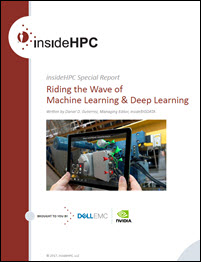This article is part of a special insideHPC report that explores trends in machine learning and deep learning. The complete report covers how businesses are using machine learning and deep learning, and then goes on to differentiate between AI, machine learning, and deep learning, including what it takes to get started.
This is the year of artificial intelligence and deep learning, when the technology is coming into its own for mainstream businesses. AI-based tools are pouring into the marketplace, but machine learning has been around for decades. So, why does this matter? In short, because we need to gain insights from massive amounts of data, and this process requires systems that exceed human capabilities. Machine learning algorithms can dig through mountains of data to ferret patterns that might not otherwise be recognizable. Moreover, machine learning algorithms get better over time, because they learn from their experiences.
[clickToTweet tweet=”This is the year of AI and deep learning, when the technology is coming into its own for mainstream businesses.” quote=”This is the year of artificial intelligence and deep learning, when the technology is coming into its own for mainstream businesses.”]
Machine learning is a subclass of AI techniques which automate the learning process through algorithms and high-powered data analytics. In recent years, advances in data science, combined with significant increases and declining cost of computing power, have yielded swelling data lakes and increasingly sophisticated analytics that have, for all practical purposes, made machine learning and AI business-ready.
Deep learning in turn, is subclass of machine learning that creates machines that use methods originally inspired by how a cat’s brain reacted with light signals and then generalized to mimic the human brain’s ability to learn. Until recently, we simply didn’t have enough data and proces- sing power to train a machine to learn. Deep neural networks (DNNs) learn at many levels of abstraction, ranging from simple concepts to complex ones. This is what designates the “deep” in deep learning. Each layer in the neural network categorizes some kind of information, refines it, and passes it along to the next layer. Deep learning lets the machine use this progression to build a hierarchical representation.
We’ve had a lot of success in deep learning and industrial applications with supervised learning solutions,” said Yoshua Bengio, Ph.D., Professor of Computer Science and Operations Research at Université de Montréal.
As an example, the first layer for a facial recognition system might look for simple edges. The next layer might look for collections of edges that form simple shapes like rectangles or circles. The third layer might identify features like eyes, ears and noses. After five or six layers, the neural network can position these features together. The result is a machine that can recognize certain objects or even concepts dependent on the training data set.
Humans learn the numbers 0 through 9 at about three to five years of age with the help of parents and teachers. Computers can learn numbers with a CPU, recognizing as many as a hundred numbers in a day. With GPUs, on the other hand, they can do this in an hour. That’s because GPUs perform many calculations at once or in parallel and, once the system is trained with GPUs, scientists, researchers and enterprise practitioners can put that learning to work.
Deep learning already has countless applications ranging from autonomous vehicles, medical diagnostics and robotics, to visual perception (such as image and video classification), speech recognition, language translation and text recognition, just to name a few.
You can download the complete report, “insideHPC Research Report on Riding the Wave of Machine Learning & Deep Learning,” courtesy of Dell EMC and Nvidia.




